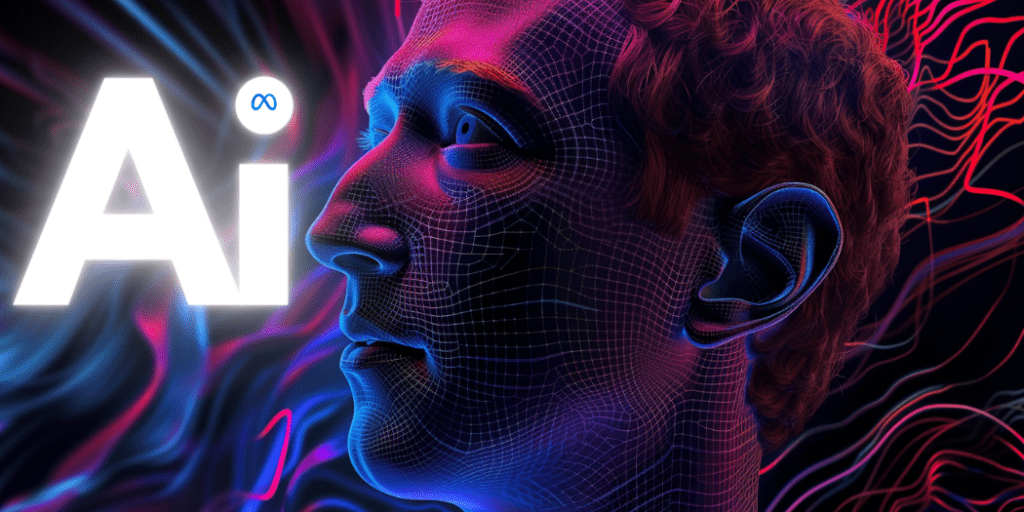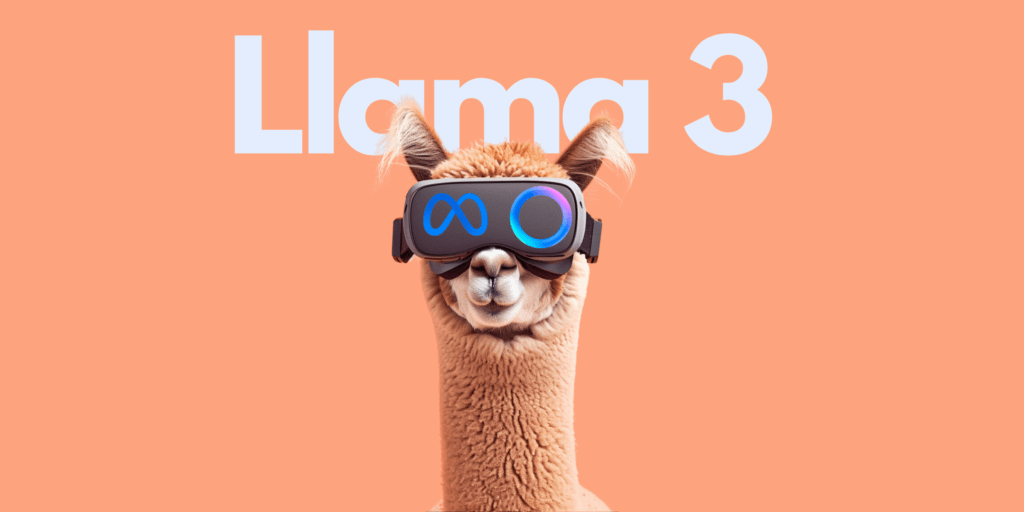Meta Llama 3 Open-Source AI Technology has once again pushed the boundaries of generative AI by introducing its latest models, the Llama 3 8B and Llama 3 70B.
These additions to the Llama series mark a significant advancement over their predecessors, featuring enhancements in computational power, training methodologies, and performance metrics.
The new models, boasting eight billion and seventy billion parameters, respectively, are designed to excel in a wide range of AI benchmarks, setting new standards for open-source AI technologies.
As the AI landscape continues to evolve, Meta’s Llama 3 models emerge as frontrunners, promising to revolutionize applications from natural language processing to complex problem-solving across various platforms.
Meta Llama 3 Open-Source AI
The Llama 3 series, launched by Meta, represents a significant upgrade in open-source generative AI models.
This new series includes two models, the Llama 3 8B and the Llama 3 70B. Each model is named for the number of parameters they contain, eight billion and seventy billion, respectively, which indicates their complexity and potential for handling diverse AI tasks.
Designed for robust performance across various benchmarks, this model is tailored to excel in tasks requiring intensive knowledge processing and reasoning.
As the more powerful of the two, this model competes directly with the top-tier generative AI models currently on the market, providing deep learning capabilities that push the boundaries of what AI can achieve in natural language understanding and generation.
These models were trained on two custom-built GPU clusters equipped with 24,000 GPU units. This substantial investment in hardware underscores Meta’s commitment to achieving cutting-edge performance and reliability in AI model training.
Meta has reported that both models have achieved impressive scores on several AI benchmarks, including the ARC and DROP. These benchmarks test the models’ abilities in areas such as knowledge acquisition, reasoning, and the handling of complex text-based information.

The Llama 3 models are particularly noted for outperforming their predecessors, the Llama 2 series, and rival models with similar parameter counts.
For instance, the Llama 3 8B model surpasses other models like Mistral’s 7B and Google’s Gemma 7B in at least nine different benchmarks, emphasizing its superior design and training.
The Llama 3 models from Meta are a leap forward in AI technology, providing enhanced capabilities that are likely to profoundly impact various applications across the tech industry.
This overview sets the stage for a deeper exploration into the specific performance enhancements and features that set the Llama 3 series apart from earlier iterations and competing models.
Performance Enhancements
Meta’s Llama 3 models represent a substantial leap forward in the capabilities of generative AI. These enhancements are not just incremental; they establish new industry performance benchmarks.
Both Llama 3 models have demonstrated exceptional performance across multiple AI benchmarks. This includes tests like the MMLU for language understanding, ARC for reasoning, and DROP, which assesses the ability to process complex text passages.
This model outperforms competitors with similar parameter sizes in benchmarks such as MMLU, ARC, DROP, GPQA, and more. It consistently exceeds performance metrics set by models like Mistral’s 7B and Google’s Gemma 7B.
In more demanding contexts, this model matches or surpasses even the most advanced models like Gemini 1.5 Pro in areas such as HumanEval, MMLU, and GSM-8K. It also beats high-profile models like Anthropic’s Claude 3 Sonnet across several benchmarks, including GPQA and MATH.
The Llama 3 models benefited from being trained on two state-of-the-art GPU clusters, each with 12,000 units, providing 24,000 GPUs dedicated to this task.
This high-performance training setup allowed for rapid iteration and refinement of model capabilities, which is critical in achieving high accuracy and reliability in benchmarks.
One of the key enhancements in training the Llama 3 models involved using synthetic data to generate longer documents.
This approach expanded the models’ exposure to various text styles and complexities. It improved their ability to understand and generate long-form content.
The training dataset for Llama 3 was approximately seven times larger than that used for Llama 2, including a fourfold increase in the amount of code, significantly enriching the models’ learning resources.
The performance enhancements of the Llama 3 models underscore Meta’s ambition to lead in the AI space, particularly in open-source models.
By setting high standards on well-regarded benchmarks, Meta enhances its products. She pushes the entire industry towards more sophisticated and capable AI systems.
These performance enhancements illustrate the robustness and versatility of the Llama 3 models, positioning them as essential tools for developers and researchers aiming to harness the full potential of AI in various applications.
Improvements of Llama 3 Models
Meta’s Llama 3 models represent significant advancements not just in terms of raw computational power but also in the sophistication of their training and testing processes.
These improvements have enabled the models to perform exceptionally across various tasks and benchmarks.
The training dataset for Llama 3 is approximately seven times larger than that used for the previous generation, Llama 2.
This expansion includes a substantial increase in the variety of data types, notably a fourfold increase in code content, significantly broadening the models’ understanding and generative capabilities in technical domains.
Meta incorporated synthetic data into the Llama 3 dataset to further enhance the training process. This addition was mainly focused on creating longer documents, which are essential for training the models to handle more extensive and complex content effectively.
Synthetic data helps simulate real-world applications more accurately, preparing the models for practical deployment scenarios.
The models were trained on two custom-built GPU clusters, each with 12,000 GPUs, totalling 24,000 units. This massive computational resource allowed for more extensive and intensive training sessions, crucial for deep learning models at this scale.
The bespoke nature of the GPU infrastructure ensures that training processes are both efficient and scalable, capable of handling the increased dataset size and complexity without compromising on performance or speed.
Alongside traditional benchmarks, Meta developed its own test sets tailored to assess the Llama 3 models’ performance across various real-world applications.

These tests include scenarios from coding and creative writing to reasoning and summarization tasks, comprehensively evaluating the models’ practical capabilities.
In testing, the Llama 3 70B model demonstrated superior performance, outperforming several competitors in tasks that span a broad range of AI applications. This indicates the model’s versatility and readiness to tackle complex challenges in a real-world environment.
The training and testing improvements implemented for the Llama 3 models have substantial implications for AI.
They enhance the performance and applicability of Meta’s models and set new standards for what is possible in open-source AI development.
By pushing the boundaries of dataset complexity and training infrastructure, Meta is paving the way for future advancements that could further revolutionize the industry.
These enhancements ensure that Llama 3 models are theoretically advanced and proven in practice across varied and demanding applications, making them valuable tools for developers and researchers looking to leverage cutting-edge AI technology.
Features and Safety
Meta’s latest Llama 3 models are advanced in their computational abilities and feature several innovations aimed at enhancing user experience and ensuring safety.
These improvements reflect a commitment to developing AI technologies that are not only powerful but also reliable and responsible.
The Llama 3 models offer enhanced steerability, which means they are better at following specific directions or prompts from users. This feature is crucial for applications requiring high customization and precision, such as content creation and tailored responses.
These models demonstrate improved performance on trivia questions and queries related to history and STEM fields. Such enhancements suggest a deeper and more nuanced understanding of complex subjects, making the models more useful for educational and professional applications.
Given the increased code in their training data, the Llama 3 models are particularly adept at generating accurate coding recommendations.
This capability is invaluable for software development, providing assistance from debugging to suggesting best practices in code optimization.
Meta has developed sophisticated data-filtering pipelines in response to the challenges of bias and toxicity inherent in large language models.
These pipelines are designed to refine the training data, ensuring that the output from the models is free from harmful biases and inappropriate content.
Meta has upgraded its safety suites, including Llama Guard and CybersecEval. These tools are aimed at enhancing the security features of the models, providing layers of protection against potential misuse and ensuring that interactions remain secure and appropriate.
Beyond initial training and deployment, Meta emphasizes the importance of ongoing monitoring and regular updates to the safety mechanisms. This approach ensures that the models adapt to new challenges and maintain high standards of ethical AI usage.
Including advanced features and robust safety measures in the Llama 3 models is critical in building user trust.
By addressing potential concerns about AI behaviour and output quality, Meta is positioning its models as tools of high technical capability and reliable and ethically sound solutions.
This dual focus on functionality and safety will likely facilitate broader adoption of Llama 3 models across various sectors, including industries that handle sensitive or critical information.
The Llama 3 models from Meta combine cutting-edge AI technology with significant improvements in usability and safety. These enhancements are set to expand the models’ applications and ensure their positive impact in a world increasingly relying on AI solutions.
Accessibility and Integration
Meta’s launch of the Llama 3 AI models marks a technological advancement and highlights a strong commitment to accessibility and integration.
These aspects are crucial in ensuring that the benefits of new AI technologies are widely available and can be seamlessly incorporated into various applications and platforms.
The Llama 3 models are accessible for download, reflecting Meta’s dedication to open-source principles. This approach allows developers worldwide to experiment with and deploy these advanced models in various settings, fostering innovation and broad application.
Llama 3 models are already being utilized to power Meta’s AI assistant across its extensive network of platforms, including Facebook, Instagram, WhatsApp, and web applications.
This integration demonstrates the models’ versatility and ability to enhance user experiences on these platforms.
Soon, the Llama 3 models will be available in a managed form across a wide range of cloud platforms, such as Databricks, AWS, Google Cloud, Hugging Face, Kaggle, IBM’s Watson, Microsoft Azure, NVIDIA’s NIM, and Snowflake.
This managed hosting ensures businesses of all sizes can leverage these powerful AI tools without requiring extensive infrastructure investments.
By hosting the models on popular cloud platforms, Meta ensures that the accessibility of Llama 3 is straightforward and scalable, allowing users to integrate these models into their systems with minimal setup time and technical overhead.
Despite its open-source nature, Meta imposes certain restrictions on its use of Llama models.
For instance, developers are prohibited from using these models to train other generative models, which is a measure likely aimed at controlling the propagation of derived technologies and maintaining quality standards.
App developers with over 700 million monthly users must request a special license to use the new models.
This requirement indicates Meta’s approach to managing the impact and distribution of its technology on a large scale, ensuring that its deployment aligns with broader business and ethical considerations.
The accessible and integrated nature of the Llama 3 models provides significant opportunities for developers and businesses.
Whether enhancing existing applications, developing new AI-driven solutions, or integrating state-of-the-art AI into user interactions, the Llama 3 models offer a versatile and powerful toolset.
The ease of access and support provided on major cloud platforms positions these models as key enablers in the next wave of AI applications across industries.
The accessibility and integration strategies employed for the Llama 3 models showcase Meta’s intention to democratize advanced AI technology while carefully managing its use and impact.
This balance is essential for fostering innovation and ensuring the responsible deployment of AI technologies in diverse environments
Future Plans and Restrictions
Meta’s development and release of the Llama 3 models mark a significant milestone in the evolution of artificial intelligence.
The company’s vision extends beyond its current capabilities, aiming to address future technological challenges and opportunities. Alongside these ambitions, Meta has also implemented specific restrictions to responsibly guide the use and development of these models.
Meta is actively working on developing even larger Llama 3 models, with plans to exceed 400 billion parameters.
These super-sized models are designed to enhance the AI’s ability to understand and generate more complex and nuanced content, potentially setting new standards for AI performance.
An exciting aspect of Meta’s roadmap is the training of Llama 3 models to converse in multiple languages and understand not just text but images.
This advancement towards multimodal AI could revolutionize how machines interact with human users and understand the world, making AI more versatile and applicable across various scenarios.
Despite being labelled as open-source, Meta has restricted how the Llama models can be used, prohibiting their use for training other generative models.
This measure is likely aimed at preventing the misuse of Meta’s technology and ensuring that the models’ capabilities are not leveraged to create unauthorized or potentially harmful AI systems.
Meta requires developers or companies with applications that attract more than 700 million monthly users to obtain a special license.
This licensing requirement ensures that Meta monitors large-scale deployments of Llama 3 models and manages directly, allowing for oversight in cases where the impact of AI is particularly broad.
These future plans and restrictions reflect Meta’s strategic approach to balancing innovation with control. By pushing the boundaries of what AI can do, Meta positions itself as a leader in the technology space. At the same time, the restrictions ensure that the growth and application of this technology are sustainable and ethical.
For developers and companies in the AI field, these developments signal exciting new possibilities and some challenges.

The potential for more advanced, multilingual, and multimodal AI models opens up unprecedented opportunities for innovation.
The restrictions imposed by Meta will require careful consideration and planning, particularly for those aiming to integrate these technologies into large-scale or commercially significant projects.
Meta’s future plans for the Llama 3 models promise to push the envelope of AI capabilities, potentially transforming multiple sectors from tech to telecommunications and beyond.
At the same time, the restrictions placed on these models underscore the importance of responsible AI development and deployment, ensuring that these advancements benefit society while mitigating risks.
Final Thoughts
The introduction of Meta’s Llama 3 models marks a pivotal moment in the evolution of artificial intelligence.
With their advanced capabilities and strategic deployment, these models not only set new benchmarks in AI performance but also redefine the possibilities of generative AI applications.
The Llama 3 models, with their vast improvements in parameter counts and training methodologies, represent a significant leap forward from their predecessors.
The enhanced steerability, accuracy in complex tasks, and safety innovations position these models at the forefront of AI technology, offering robust, powerful, and reliable solutions.
By making these models open-source and integrating them into various platforms, Meta democratizes access to cutting-edge AI technology.
This move spurs innovation across industries and facilitates a broader adoption of AI, potentially transforming fields such as education, healthcare, entertainment, and more.
With plans to develop even larger and more capable models that can understand multiple languages and modalities, Meta is not resting on its laurels.
The future trajectory of the Llama 3 series promises even more sophisticated AI tools capable of more naturally interacting with users and handling a more comprehensive array of tasks.
Meta’s approach to imposing thoughtful restrictions on the usage of Llama 3 models reflects a commitment to responsible AI development.
This balance is crucial in ensuring that the advancements in AI contribute positively to society and do not lead to unintended negative consequences.
Meta’s continuous investment in AI and its strategic direction in developing and deploying the Llama 3 models underscore the company’s role as a leader in the tech industry.
This leadership is about advancing technology and shaping the future of how AI is integrated into our daily lives and industries.
The Llama 3 models are more than just a technological update; they are a significant step towards realizing the full potential of AI.
As these models evolve and become integrated into various platforms and industries, they will likely play a crucial role in shaping the future of AI applications, making technology more accessible, efficient, and impactful for everyone.


